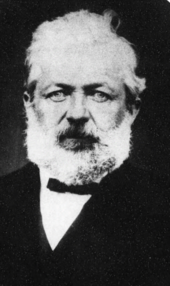Gottfried Wagener
Gottfried Wagener (born July 5, 1831 in Hanover , † November 8, 1892 in Tokyo ) was a German scientist and technician who played a major role in the development of engineering studies in Japan .
Life
Wagener studied mathematics, physics, chemistry and mechanics in Göttingen and passed the senior teacher examination in 1851. The subject of this thesis "Presentation of the different methods to determine the acceleration of gravity" led him to problems that are significant for seismology . From 1852 to 1860 he stayed in Paris and from 1860 to 1864 he worked as a teacher at a technical college in Switzerland. In 1868 he was in the service of the American trading firm Russell & Co. to Nagasaki . The brother of the company owner, John G. Walsh, had Wagener accompany him to Japan to set up a soap factory. The company was a failure and so on behalf of the governor of Hizen in Arita he built the first stoves equipped for hard coal for the local porcelain manufacturer.
At the end of 1870 he got a job as a teacher at the Kaiseijo in Tokyo , where he gave German lessons in addition to mathematics and natural sciences. After changing teaching activities, he was appointed lecturer at the Imperial University that emerged from the Kaiseijo in 1882. In 1884 he entered the Tokyo Art and Crafts School as the main head of the ceramic and glass engineering department. Here he was able to develop his abilities most abundantly until his death.
Wagener's work has been invaluable to Japan. With words and deeds, he worked on converting the traditional industry for the European market. He rendered excellent service when Japan participated in the 1873 World's Fair in Vienna. The unimagined success there encouraged participation in the 1876 World's Fair in Philadelphia, to which Wagener was again sent as the representative of the Japanese government.
In his time, Wagener was the most prominent figure in the German Society for Natural History and Ethnology of East Asia (OAG), of which he was chairman from 1883 to 1886. The grateful host country honored his memory: in 1924 a memorial was erected in Kyōto, and in 1937 a memorial on the site of his institution, the Tokyo Institute of Technology (TIT), which he was promoted to in 1929, of which he was a founding member. He died in Tokyo and is buried in the Aoyama Cemetery.
Since 2008, the German Science and Innovation House Tokyo (DWIH Tokyo) has been awarding the "Gottfried Wagener Prize" annually at the DIHK in Japan as an innovation prize for Japanese scientists.
literature
- German work in Japan . In: M. Ramming (Hg): Japan-Handbuch . Steiniger-Verlag, Berlin 1941
- oA: Nekrolog for Dr. Gottfried Wagener. In: Mitteilungen der OAG, Volume VI (1893–1897), Issue 57. German Society for Nature and Ethnology of East Asia , pp. 357–364 , accessed on November 6, 2012 (To view the source, the installation of a DjVu plug-in is required .).
Web links
- Gottfried Wagner (1830-92)
- Bernd Lepach: Wagener, Gottfried on the Meiji Portraits website
Individual evidence
- ↑ a b c Nekrolog for Dr. Gottfried Wagener. German Society for Natural History and Ethnology of East Asia, pp. 357–364 , accessed on November 6, 2012 .
- ↑ German Innovation Award. (No longer available online.) German Science and Innovation House - Tokyo, archived from the original on November 13, 2015 ; accessed on March 7, 2015 . Info: The archive link was inserted automatically and has not yet been checked. Please check the original and archive link according to the instructions and then remove this notice.
| personal data | |
|---|---|
| SURNAME | Wagener, Gottfried |
| ALTERNATIVE NAMES | Wagner, Gottfried (common misspelling) |
| BRIEF DESCRIPTION | Scientists and technicians |
| DATE OF BIRTH | July 5, 1831 |
| PLACE OF BIRTH | Hanover |
| DATE OF DEATH | November 8, 1892 |
| Place of death | Tokyo |


